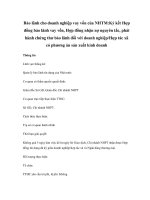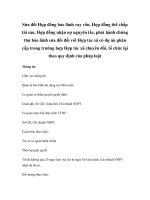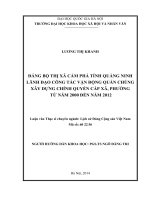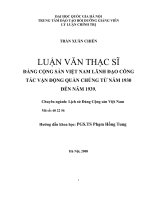Nguyên tắc vận động chung
Bạn đang xem bản rút gọn của tài liệu. Xem và tải ngay bản đầy đủ của tài liệu tại đây (3.87 MB, 39 trang )
Principles of Joint Mobilization
Edward P. Mulligan, MS, PT, SCS, ATC
VP, National Director of Clinical Education
HealthSouth Corporation – Grapevine, TX
Clinical Instructor
University of Texas Southwestern PT Department
Dallas, TX
The contents of this presentation are copyrighted © 2001 by continuing ED. They may not be utilized,
reproduced, stored, or transmitted in any form or by any means, electronic or mechanical, or by any
information storage or retrieval system, without permission in writing from Edward P. Mulligan.
continuing ED
Joint Mobilization
skilled passive
movement of the
articular surfaces
performed by a
physical therapist
to decrease pain
or increase joint
mobility
continuing ED
1
Presentation Objectives
Define osteokinematic and arthrokinematic motion
Explain the arthrokinematic rules of motion
Detect and classify joint dysfunction
Define the resting and closed pack position of a joint
Understand the treatment application principles
that govern passive joint mobilization
s Investigate what the literature suggests regarding
mobilization effectiveness and efficacy
t Memorize the morphological and capsular characteristics of each joint
u Demonstrate selected joint mobilization techniques
n
o
p
q
r
continuing ED
Objective 1
Define osteokinematic and
arthrokinematic motion
continuing ED
2
Osteokinematics
“Motion You SEE”
observable movements of bones in space as
represented
by a change in the angle of adjacent articular
segments
continuing ED
Arthrokinematics
“Motion You FEEL”
• Unobservable articular accessory motion between
adjacent joint surfaces
¾
roll, glide, and spin
• These accessory motions take place with all
active and passive movements and are necessary
for full, pain free range of motion
• Arthrokinematic motion can not occur independently or voluntarily and if restricted, can limit
physiological movement
continuing ED
3
Types of Arthrokinematic Motion
Joint Play
¾ movement not under voluntary control (passive)
¾ can not be achieved by active muscular contraction
versus
Component Movement
¾ involuntary obligatory joint motion occurring outside
the joint accompanies active motion
– i.e. - scapulohumeral rhythm
continuing ED
Arthrokinematic ROLL
• new points on one
surface come into
contact with new
points on the other
surface (wheel)
• rolling only occurs
when the two
articulating
surfaces are
incongruent
continuing ED
4
Arthrokinematic GLIDE
• translatory motion in which
one constant point on one
surface is contacting new
points or a series of points
on the other surface
• pure gliding can occur
when two surfaces are
congruent and flat or
congruent and curved
• glide also referred to as
translation
braking analogy
continuing ED
Arthrokinematic SPIN
• rotation around a
longitudinal stationary
mechanical axis (one
point of contact) in a
CW or CCW direction
loss of traction analogy
continuing ED
5
Arthrokinematic Motions
Concave on Convex
continuing ED
Arthrokinematic Motions
Convex on Concave
continuing ED
6
ROLLING and GLIDING
• Since there is never pure congruency
between joint surfaces; all motions
require rolling and gliding to occur
simultaneously
• This combination of roll and glide is
simultaneous but not necessarily in
proportion to one another
continuing ED
Arthrokinematic Motions
The more congruent - the more the gliding
The more incongruent - the more the rolling
B
Pure Spin: B contacts point 1
x
A
1
2
3
continuing ED
7
Arthrokinematic Motions
The more congruent - the more the gliding
The more incongruent - the more the rolling
Pure Glide: A contacts point 2
B
x
A
A
1
2
3
continuing ED
Arthrokinematic Motions
The more congruent - the more the gliding
The more incongruent - the more the rolling
Pure Roll: B contacts point 3
B
x
B
A
1
2
3
continuing ED
8
Arthrokinematic Motions
The more congruent - the more the gliding
The more incongruent - the more the rolling
Glide and Roll: B contacts point 2
B
x
A
1
B
2
3
continuing ED
Objective 2
Explain the arthrokinematic
rules of motion
continuing ED
9
Joint Morphology
Joint surfaces are defined as:
Convex:
male; rounded or arched
Concave: female; hollowed or shallow
continuing ED
Joint Morphology
Joint surfaces are defined as:
Ovoid:
concave and convex articular partner surface
Sellar: saddle shape with each articular surface having a
concave and convex component in a specific
direction
• Examples would include the
sternoclavicular and 1st carpometacarpal
joints
continuing ED
10
Concave and Convex Characteristics
• convex surfaces have more
cartilage at the center
• concave surfaces have more
cartilage on the periphery
• where surfaces appear flat the larger articular surface
is considered convex
continuing ED
Rules of Motion
Concave Motion Rule
• convex surface is stationary and
concave surface moves
• osteo and arthrokinematic motion is in the
same direction
• arthrokinematic mobilization gliding force is in the
same direction as osteokinematic
bony movement
GLIDE and ROLL are in the SAME DIRECTION
continuing ED
11
Rules of Motion
Convex Motion Rule
• concave surface is stationary and
convex surface moves
• osteo and arthrokinematic motion
is in the opposite direction
• arthrokinematic mobilization gliding
force is in the opposite direction as
osteokinematic bony movement
GLIDE and ROLL are in the OPPOSITE DIRECTION
continuing ED
Rules of Motion
• because their is always
incongruent surfaces,
there must be some
combination of glide
and roll
• arthrokinematic roll
always occurs in the
same direction as bony
movement regardless
of whether the joint
surface is convex or
concave in shape.
femur stationary
tibia stationary
continuing ED
12
Functional Roll and Glide Analogy
The more congruent
– the more glide
The more incongruent
– the more roll
Joint incongruency
requires rolling and
gliding in combination
continuing ED
Obligate Translation
• During AROM translation direction is influenced by the
capsuloligamentous complex
• Passive restraints act not only to restrict movement but
also to reverse articular movements at the end range
of motion
Convex-Concave Morphology vs.
Capsular Obligate Translation
• At end range, asymmetrical capsular mobility causes obligate
translation away from the side of tightness
• Tight capsular structures will cause early and excessive
accessory motion in the opposite direction of the tightness
continuing ED
13
secondary to capsular tightness asymmetry
continuing ED
Treatment Plane and Axis of Motion
The treatment plane lies in the concave articular surface
and is parallel to the joint surface and perpendicular to
the axis in the convex surface
The axis of motion always lies in the convex articular surface
The treatment plane moves with the concave surface moves
The treatment plane remains essentially still when the
convex surface moves
continuing ED
14
TRACTION
• the process of pulling
one bony surface away
from the other (joint
separation)
• passive translatoric bone
movement which is at a
right angle to the
treatment plane
continuing ED
GLIDING
• Translatory movement
where the joint surfaces
are passively displaced
parallel to the
treatment plane
continuing ED
15
Objective 3
Detect and classify joint
dysfunction
continuing ED
Detect and Classification of Joint Dysfunction
Cause of Limited Motion
Identification
Treatment Intervention
ROM unaffected by
proximal or distal joint
positioning
Capsular End Feel
MOBILIZE
Shortened Extra-articular
Muscle Groups
ROM affected by proximal
or distal joint positioning
STRETCH
Muscle Weakness
ROM affected by gravity
STRENGTHEN
Pain
Empty end feel
MODALITIES
Grade I-II Mobs
Nerve Root Adhesion
Neural Tension Tests
NEURAL MOBILIZATION
Soft Tissue Restrictions
Palpation
SOFT TISSUE
MOBILIZATION
Intra-articular Adhesions or
Pericaspsular Stiffness
•
•
continuing ED
16
Determination of Joint Mobility
•
•
•
•
•
difficult to assess
quantity graded in millimeters
quality graded by “end feel”
poor intra/intertester reliability
best gauged by comparison to
uninvolved side
continuing ED
Determination of Joint Mobility
Direct Method
• manual assessment of decreased
accessory motion in all directions
Indirect Method
• after noting decreased active and/or passive range of
motion; apply the convex/concave rules to determine the
direction of limited mobility
• This method is used when
– patient has severe pain
– joint is extremely hypomobile
– therapist is inexperienced with direct assessment
continuing ED
17
CLASSIFICATION of JOINT MOBILITY
Ordinal Scale
GRADE
DEFINITION
TREATMENT POSSIBILITIES
No attempts should be made to mobilize
1
No Movement – joint
ankylosed
Extremely hypomobile
Mobilization
2
Slightly hypomobile
Mobilization-Manipulation
3
Normal
No dysfunction; no treatment needed
4
Slightly hypermobile
5
Extremely hypermobile
6
Unstable
Look for hypomobility in adjacent joints.
Exercise, taping, bracing, etc
Look for hypomobility in adjacent joints.
Exercise, taping, bracing, etc
Bracing, splinting, casting,
surgical stabiliztion
0
continuing ED
MOTION SCHEMATIC
INSTABILITY
Disruption Strain
Disruption
SLACK
Joint
Dislocation Sprain Play
Dislocation
LAXITY
Active
Movement
Resting
Position
SLACK INSTABILITY
Active
Joint
Movement Play
Strain
Sprain
ACTIVE RANGE of MOTION
PHYSIOLOGICAL LIMIT of MOTION
ANATOMICAL LIMIT of MOTION
POTENTIAL DISABILITY
continuing ED
18
Objective 4
Define the resting and closed
pack position of a joint
continuing ED
Joint Positions and Congruence
• Articular surfaces are rarely, if ever, in total
congruence
• The area of contact or congruence at any
particular point in the range of motion is
relatively small compared to the surface area
• Allows for better lubrication and recovery time
for the articular surfaces
continuing ED
19
RESTING POSITION
• Surrounding tissue is as lax as possible
– maximum incongruency
• Intracapsular space is as large as
possible
• Position sought at rest or following acute
trauma to accommodate maximal fluid
accumulation
• Unlocked, statically inefficient for load bearing,
and dynamically safe
• Treatment position
– max amount of joint play available
continuing ED
CLOSED PACK POSITION
• Joint positions are most congruent
• Surrounding tissue (capsules and
ligaments) under maximal tension
• Intracapsular space is minimal
• Locked, statically efficient for load
bearing, and dynamically dangerous
• Testing position
– ex: apprehension test of GH joint
continuing ED
20
Objective 5
Understand the treatment
application principles that
govern passive joint
mobilization
continuing ED
mobilization treatment
• Mobilization (movement) to a joint may:
– fire articular mechanoreceptors
– fire cutaneous and muscular
receptors
– abate nocioceptors
– decrease or relax muscle
guarding
continuing ED
21
mobilization treatment
Therapeutic Effects of Mobilization include:
– stimulate synovial fluid
movement to nourish cartilage
– maintain/promote periarticular
extensibility
– provide sensory input
continuing ED
mobilization indications
• pain relief
• decrease muscle guarding
or spasm
• treat reversible joint
hypomobility of capsular
origin
continuing ED
22
mobilization treatment variables
• Joint position
• Direction of mobilization
• Type of mobilization
– oscillation vs. sustained hold
• Grade (intensity) of mobilization
• Mobilization dosage
continuing ED
translatory glide mobilization grading
Grade I – small amplitude movement at the beginning of the available ROM
Grade II – large amplitude movement at within the available ROM
Grade III – large amplitude movement that reaches the end ROM
Grade IV – small amplitude movement at the very end range of motion
Grade V – high velocity thrust of small amplitude at the end of the available
range and within its anatomical range (manipulation)
continuing ED
23
distraction mobilization grading
Grade I – unweighting or barely supporting the joint surfaces (picolo)
– equalizes cohesive and atmospheric forces of the joint
– alleviates pain by unloading and decompressing
– nullifies normal compressive forces
Grade II – slack of the capsule taken up (eliminates joint pain)
Grade III – capsule and ligaments stretched
continuing ED
mobilization treatment considerations
• Grades I and II
– "neurophysiological effect used daily to treat
pain"
– pain relief through neuromodulation on the
sensory
innervation
of
the
joint
mechanoreceptors and pain receptors
– ”gates pain achieved by the inhibition of
transmission of nocioceptive stimuli at the
spinal cord and brain stem level
– neutralizes joint pressures
– prevents grinding
continuing ED
24
mobilization treatment considerations
Grades III-V
– “mechanical effect used 3-5 times/week to
treat stiffness or hypomobility”
• increase ROM through
promotion of capsular mobility
and plastic deformation
• mechanical distention and/or
stretching of shortened tissues
continuing ED
mobilization treatment principles
Oscillations
– 60-120/min
– 1-5 sets of 5-60 sec
– generally used to treat
pain
Prolonged Hold
– 5-30 seconds
– 1-5 reps
– typically applied at end
range to treat stiffness
• Oscillations or prolonged
hold at mid-range
stimulates type I
mechanoreceptors
• Oscillations or prolonged
hod at end range
stimulates type II
mechanoreceptors
• Low grade sustained hold
stimulates type III
mechanorceptors and
inhibits guarding
continuing ED
25









